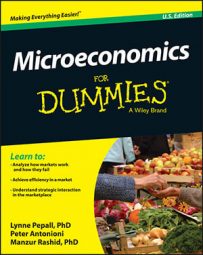One of the key insights into how a market economy organizes production is the concept in microeconomics of a firm: an entity or agent that produces things.
The best approach to start thinking about the firm is in a simple way, by considering the smallest possible unit of production: a single-person-operated firm such as a market stall (in the U.S., this is called sole proprietor). This section also introduces you briefly to other types of firms.
Looking at this sole proprietor firm, an economist would want to make some general statements about what it does, and why it does it. Therefore, microeconomists abstract away any particular features such as special features about its operation that aren't generalizable across industries or markets unless they're absolutely necessary. The simplest way to do this is to turn to the foundation of business and accounting and make some general statements about the costs and benefits that accrue.
Recognizing the importance of profit
At its most basic, a firm takes some things in, transforms them in some way, and places what it produced on the market hoping that the difference between what it receives (revenues) is bigger than the costs of taking those things in and transforming them (costs). That difference is called profit (or if you're unfortunate in running your firm, loss, which economists write as a negative profit). The Greek symbol pi denotes profit so that you can write the following simple equation:
The equation says that the total profit the firm makes is the difference between all revenues that the firm takes in and all costs that the firm incurs to conduct its activities.
At this stage, you haven't done anything to break down those costs into corresponding production activities, and so for the moment the sole proprietor's costs include not only the cost of goods bought in and the cost of labor, but also the fixed costs of its operation, that is, the rent due on the stall irrespective of how many things are sold individually.
At heart, economists treat every firm in this way. Of course, firms vary considerably in size and complexity, and comparing the activities of a transnational corporation to a market stall trader would be a little simplistic. But all firms share in common the profit motivation, and profit is the indicator of revenues being in excess of costs. A rational firm (in economic terms) seeks to maximize it.
Profits accrue after all relevant costs have been paid, including what the sole proprietor gave up in terms of alternative use of their time in order to open up the stall. This approach is slightly different from an accountant's point of view, where several different accounting measures and accounting terms are used to indicate firm profitability. Typically, these terms include income, earnings, or net or gross profit, depending on which part of the firm's accounts you're looking at.
Economists take a more general view on profit than accountants, and to an economist there is only one way to measure profit.
Discovering types of firms
Many firms are of course significantly more complex than the sole proprietor mentioned in the preceding section.
Company law distinguishes a few types of firms according to how profits or losses earned by the firm are distributed, including:
Partnership: There are several owners of the firm that are permitted to share in any profits generated by its business and are equally liable for all its losses.
Limited liability company (LLC): An entity that the law defines as owning the profits which may then be redistributed to those who own the company, called shareholders. In a limited liability company, shareholders are only liable for losses up to the stake they hold in the company.
Co-operative: Owned and operated by its members. Typically, it redistributes profits to those members.
Each of these types of firm has legal advantages in certain situations and drawbacks in other situations. For instance, the limited liability company has advantages in its ability to raise capital but disadvantages in terms of the ability of the shareholders to run the company or to observe and control the activities of managers.

